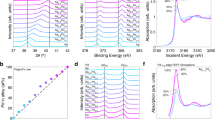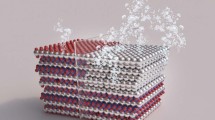Abstract
A careful choice of the surface coverage of iron phthalocyanine (FePc) on Ag (110) around the single monolayer allows us to drive with high precision both the long-range supramolecular arrangement and the local adsorption geometry of FePc molecules on the given surface. We show that this opens up the possibility of sharply switching the catalytic activity of FePc in the oxygen reduction reaction and contextual surface oxidation in a reproducible way. A comprehensive and detailed picture built on diverse experimental evidence from scanning tunnelling microscopy, X-ray photoelectron spectroscopy and X-ray absorption spectroscopy, coupled with density functional theory calculations, sheds new light on the nature of the catalytically active molecule–surface coordination and on the boundary conditions for its occurrence. The results are of relevance for the improvement of the catalytic efficiency of metallo-macrocycles as viable substitutes for platinum in the cathodic compartment of low-temperature fuel cells.
This is a preview of subscription content, access via your institution
Access options
Subscribe to this journal
Receive 12 print issues and online access
$259.00 per year
only $21.58 per issue
Buy this article
- Purchase on Springer Link
- Instant access to full article PDF
Prices may be subject to local taxes which are calculated during checkout






Similar content being viewed by others

References
Davis, J. J., Orlowski, G. A., Rahman, H. & Beer, P. D. Mechanically interlocked and switchable molecules at surfaces. Chem. Commun. 46, 54–63 (2010).
Schmaltz, B., Weil, T. & Müllen, K. Polyphenylene-based materials: control of the electronic function by molecular and supramolecular complexity. Adv. Mater. 21, 1067–1078 (2009).
Auwaerter, W. et al. A surface-anchored molecular four-level conductance switch based on single proton transfer. Nature Nanotech. 7, 41–46 (2012).
De Oteyza, D. G. et al. Customized electronic coupling in self-assembled donor–acceptor nanostructures. Adv. Funct. Mater. 19, 1–7 (2009).
Browne, W. R. & Feringa, B. L. Light switching of molecules on surfaces. Ann. Rev. Phys. Chem. 60, 407–428 (2009).
Dintinger, J., Klein, S. & Ebbesen, T. W. Molecule–surface plasmon interactions in hole arrays: Enhanced absorption, refractive index changes, and all-optical switching. Adv. Mater. 18, 1267–1270 (2006).
Gambardella, P. et al. Supramolecular control of the magnetic anisotropy in two-dimensional high-spin Fe arrays at a metal interface. Nature Mater. 8, 189–193 (2009).
Gatteschi, D., Cornia, A., Mannini, M. & Sessoli, R. Organizing and addressing magnetic molecules. Inorg. Chem. 48, 3408–3419 (2009).
Sun, Y., Chen, K., Jia, L. & Li, H. Toward understanding macrocycle specificity of iron on the dioxygen-binding ability: A theoretical study. Phys. Chem. Chem. Phys. 13, 13800–13808 (2011).
Flechtner, K., Kretschmann, A., Steinrueck, H-P. & Gottfried, J. M. NO-induced reversible switching of the electronic interaction between a porphyrin-coordinated cobalt ion and a silver surface. J. Am. Chem. Soc. 129, 12110–12111 (2007).
Wäckerlin, C. et al. Controlling spins in adsorbed molecules by a chemical switch. Nature Commun. 61, 1–7 (2010).
Isvoranu, C. et al. Tuning the spin state of iron phthalocyanine by ligand adsorption. J. Phys. Condens. Matter 22, 472002 (2010).
Isvoranu, C. et al. Ammonia adsorption on iron phthalocyanine on Au(111): Influence on adsorbate–substrate coupling and molecular spin. J. Chem. Phys. 134, 114710 (2011).
Hulsken, B. et al. Real-time single-molecule imaging of oxidation catalysis at a liquid–solid interface. Nature Nanotech. 2, 285–289 (2007).
Li, W., Yu, A., Higgins, D. C., Llanos, B. G. & Chen, Z. Biologically inspired highly durable iron phthalocyanine catalysts for oxygen reduction reaction in polymer electrolyte membrane fuel cells. J. Am. Chem. Soc. 132, 17056–17058 (2010).
Tolman, W. B. & Solomon, E. I. Preface: Forum on dioxygen activation and reduction. Inorg. Chem. 49, 3555–3556 (2010).
Scherson, D. A., Palencsar, A., Tolmachev, Y. & Stefan, I. in Electrochemical Surface Modification: Thin Films, Functionalization and Characterization (eds Alkire, R. C., Kolb, D. M., Lipkowski, J. & Ross, P. N.) Ch. 3, 191–288 (Book series: Advances in Electrochemical Science and Engineering, Vol. 10, Wiley, 2008).
Gewirth, A. A. & Thorum, M. S. Electroreduction of dioxygen for fuel-cell applications: Materials and challenges. Inorg. Chem. 49, 3557–3566 (2010).
Birry, L., Zagal, H. J. & Dodelet, J-P. Does CO poison Fe-based catalysts for ORR? Electrochem. Comm. 12, 628–631 (2010).
Casarin, M. et al. Coverage-dependent architectures of iron phthalocyanine on Ag(110): A comprehensive STM/DFT Study. J. Phys. Chem. C 4, 2144–2153 (2010).
Campbell, C. T. & Paffett, M. T. The interaction of O2, CO and CO2 with Ag(110). Surf. Sci. 143, 517–535 (1984).
Floreano, L. et al. Periodic arrays of Cu-phthalocyanine chains on Au(110). J. Phys. Chem. C. 112, 10794–10802 (2008).
Molodtsova, O. V., Knupfer, M., Ossipyan, Yu. A. & Aristov, V. Yu. Molecular orientation and ordering in CoPc and FePc thin films grown on Au(001)- 5 × 20. J. Appl. Phys. 104, 083704 (2008).
Giannozzi, P. et al. QUANTUM ESPRESSO: A modular and open-source software project for quantum simulations of materials. J. Phys. Condens. Matter 21, 395502 (2009).
Tersoff, J. & Hamann, D. R. Theory and application for the scanning tunneling microscope. Phys. Rev. Lett. 50, 1998–2001 (1983).
Garcı´a de Abajo, F. J., Van Hove, M. A. & Fadley, C. S. Multiple scattering of electrons in solids and molecules: A cluster-model approach. Phys. Rev. B 63, 075404 (2001).
Tsukahara, N. et al. Adsorption-induced switching of magnetic anisotropy in a single iron(II) phthalocyanine molecule on an oxidized Cu(110) surface. Phys. Rev. Lett. 102, 167203 (2009).
Scherlis, D. A., Cococcioni, M., Sit, P. & Marzari, N. Simulation of heme using DFT + U: A step toward accurate spin-state energetics. J. Phys. Chem. B 111, 7384–7391 (2007).
Sachtler, W. M. H. The mechanism of the catalytic oxidation of some organic molecules. Catal. Rev. 4, 27–52 (1970).
Boronin, A. I., Koscheev, S. V. & Zhidomirov, G. M. XPS and UPS study of oxygen states on silver. J. Electron Spectrosc. Relat. Phenom. 96, 43–51 (1998).
Engelhardt, H. A. & Menzel, D. Adsorption of oxygen on silver single crystal surfaces. Surf. Sci. 57, 591–618 (1976).
Pai, W. W., Bartelt, N. C., Peng, M. R. & Reutt-Robey, J. E. Steps as adatoms sources for surface chemistry: Oxygen overlayer formation on Ag(110). Surf. Sci. 330, L679–L685 (1995).
Savio, L., Vattuone, L. & Rocca, M. From adsorption at the surface to incorporation into subsurface sites: The role of steps for O/Ag. Appl. Phys. A 87, 399–404 (2007).
Horcas, I. et al. WSXM: A software for scanning probe microscopy and a tool for nanotechnology. Rev. Sci. Instrum. 78, 013705 (2007).
Floreano, L. et al. Performance of the grating-crystal monochromator of the ALOISA beamline at the Elettra Synchrotron. Rev. Sci. Instrum. 70, 3855–3864 (1999).
Perdew, J. P., Burke, K. & Ernzerhof, M. Generalized gradient approximation made simple. Phys. Rev. Lett. 77, 3865–3868 (1996).
Vanderbilt, D. Soft self-consistent pseudopotentials in a generalized eigenvalue formalism. Phys. Rev. B 41, 7892–7895 (1990).
Marzari, N., Vanderbilt, D., De Vita, A. & Payne, M. C. Thermal contraction and disordering of the Al(110) surface. Phys. Rev. Lett. 82, 3296–3299 (1999).
Acknowledgements
This work has been partially funded by MIUR (PRIN 2008, Project n. 2008MXZEAS: ‘Molecular SPACE’) and by the University of Padova (Progetto Strategico STPD08RCX5_003 ‘HELIOS’ and Progetti di Ricerca di Ateneo - CPDA118475/11).
Author information
Authors and Affiliations
Contributions
F.S., M.D.M. and D.F. contributed equally to this work.
Corresponding author
Ethics declarations
Competing interests
The authors declare no competing financial interests.
Supplementary information
Supplementary Information
Supplementary Information (PDF 654 kb)
Supplementary Information
Supplementary Movie S1 (MOV 11252 kb)
Rights and permissions
About this article
Cite this article
Sedona, F., Di Marino, M., Forrer, D. et al. Tuning the catalytic activity of Ag(110)-supported Fe phthalocyanine in the oxygen reduction reaction. Nature Mater 11, 970–977 (2012). https://doi.org/10.1038/nmat3453
Received:
Accepted:
Published:
Issue Date:
DOI: https://doi.org/10.1038/nmat3453
This article is cited by
-
Advances in bio-inspired electrocatalysts for clean energy future
Nano Research (2024)
-
Effects of Various Cross Sections on Elastoplastic Behavior of Fe Nanowires under Tension/Compression
Journal of Materials Engineering and Performance (2023)
-
Application of Scanning Tunneling Microscopy in Electrocatalysis and Electrochemistry
Electrochemical Energy Reviews (2021)
-
Iron phthalocyanine with coordination induced electronic localization to boost oxygen reduction reaction
Nature Communications (2020)
-
Fe azaphthalocyanine unimolecular layers (Fe AzULs) on carbon nanotubes for realizing highly active oxygen reduction reaction (ORR) catalytic electrodes
NPG Asia Materials (2019)


